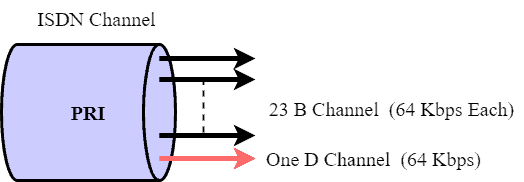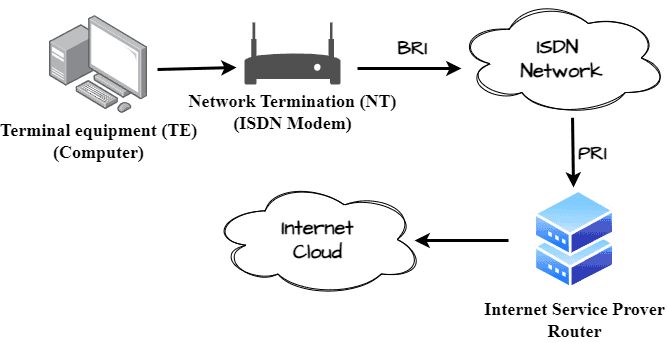1. Introduction
In this tutorial, we’ll talk about the Integrated Services Digital Network (ISDN) along with its working principle.
2. What Is an ISDN?
Integrated Services Digital Network, commonly known as ISDN, is a telephone network system that marked a significant shift from the traditional analog Public Switched Telephone Network (PSTN) to the digital age. It utilizes circuit-switching to transmit both voice and data over a digital line.
These digital lines consist of copper wires, with the original intention of developers being to replace analog landline technology with digital technology. However, complete standardization of this transition was never achieved. This leads to achieving superior voice or data quality compared to what an analog phone can offer.
3. Components of an ISDN
Comprehending the fundamental elements that contribute to the seamless functioning of an ISDN is crucial for understanding its operational dynamics. Channels are pivotal in transmitting voice and data within the ISDN framework. The ISDN system utilizes two main types of channels:
3.1. B Channels (Bearer)
The B channel, abbreviated for Bearer Channel, carries user data, such as voice, video, or computer data. It’s like the information pipeline transporting conversations and file data in digital packets.
Each B channel operates at a rate of 64 kbps. The number of B channels available depends on the type of ISDN service.
3.2. D Channels (Data)
The D channel serves the primary function of transporting signaling information and control messages between the user’s terminal equipment (such as an ISDN device or telephone) and the central office or exchange in the telecommunications network.
The bandwidth of the D channel depends on the type of ISDN service but typically operates at a speed of 16 kbps.
The combination of B channels and D channels allows an ISDN to support various services simultaneously over a single digital connection. This division of channels is a key feature of ISDN, enabling the efficient and flexible transmission of voice, data, video, and other services.
4. Types of ISDNs
ISDN (Integrated Services Digital Network) lines come in two primary types: Basic Rate Interface (BRI) and Primary Rate Interface (PRI). Each type serves different needs and is designed to accommodate various usage scenarios.
4.1. Basic Rate Interface (BRI)
Designed for residential and small business use, BRI provides a digital communication service over traditional telephone lines. It offers a more versatile and efficient alternative to traditional analog phone lines:
BRI consists of two B (Bearer) channels and one D (Data) channel. The two B channels carry user data, such as voice, data, or video. The D channel handles signaling and controlling information. It provides a total bandwidth of 144 kbps (64 kbps + 64 kbps + 16 kbps).
4.2. Primary Rate Interface (PRI)
PRI offers an enhanced communication service designed for larger organizations and businesses with higher communication demands. It provides a higher capacity and more channels compared to BRI, making it suitable for scenarios with greater data and voice traffic.
PRI comprises 23 B channels (sometimes 30 B channels depending on region) for carrying user data and one D channel for signaling:
The total bandwidth of PRI depends on the number of B channels. For example, in the U.S., a PRI provides a total bandwidth of 1.544 Mbps (23 B channels + 1 D channel), while in Europe, a PRI provides a total bandwidth of 2.048 Mbps (30 B channels + 1 D channel).
4.3. B (Broadband) ISDN
Broadband ISDN expands on traditional ISDN, providing higher data rates and increased flexibility for diverse services to meet the growing demand for advanced multimedia applications like high-speed internet, video conferencing, and other broadband services.
B-ISDN boasts significantly higher data rates than the original ISDN, which typically offers data rates ranging from 64 Kbps to 128 Kbps. In contrast, B-ISDN can provide notably faster speeds, often reaching into the Mbps range.
Broadband ISDN employs ATM switching technology and operates over fiber-optic cables, representing an advanced iteration of ISDN.
5. Core Principles and Architecture
ISDN divides the conventional copper telephone line into several digital channels, enabling multiple phones to make incoming and outgoing calls simultaneously on a single copper line. Achieving this involves operating these channels concurrently on the same physical line.
When we speak or send data on an ISDN phone, translating the voice into digital data packets occurs through pulse code modulation (PCM). Similarly, the system packages data files into data packets. The architecture of ISDN comprises several key components:
Terminal equipment (TE) is the user’s device or equipment that connects to the ISDN network. It can be a telephone, computer, fax machine, or any other device capable of digital communication called TE1, and for higher bandwidth connections, terminal equipment is called TE2:

The Network Termination (NT) links the user’s equipment to the ISDN network, carrying out tasks like line coding, ensuring electrical compatibility, and interfacing with the user’s device.
The User-Network Interface (UNI) delineates the connection point between the customer’s equipment (TE1 or TE2) and the network, encompassing the essential physical and electrical characteristics for effective communication.
At the core of the ISDN architecture is the ISDN switch, tasked with establishing, managing, and terminating connections among various ISDN users. This switch exhibits the capability to manage both voice and data traffic.
6. Applications
Various applications have utilized the Integrated Services Digital Network (ISDN), which provides a versatile platform for digital communication. Here are several applications of ISDNs:
ISDN supports high-quality digital voice communication. It provides clear and reliable voice connections, making it suitable for traditional telephone calls.
The digital nature of ISDN makes it well-suited for video conferencing applications. It can transmit and receive video signals, facilitating real-time communication between individuals or groups in different locations.
Users have employed ISDN for internet access, obtaining higher data rates than traditional dial-up connections. While it has been largely surpassed by broadband technologies like DSL and cable modems, ISDN was an early solution for achieving faster internet speeds.
ISDN has played a role in establishing Virtual Private Networks, offering secure and encrypted communication over public networks.
7. Challenges and Future of ISDN
ISDN provides limited bandwidth compared to modern broadband technologies. As the demand for higher data rates and multimedia applications increased, ISDN’s capacity became insufficient.
The services were initially expensive, making them less attractive to consumers and businesses, especially when more affordable broadband options became available.
Installing and configuring ISDN services could require specialized equipment and expertise. In contrast, newer technologies, like DSL, offered simpler installations.
8. Conclusion
In this article, we discussed ISDN, which utilizes circuit switching to transmit voice and data over a digital line. These electronic pathways comprise copper wiring, originally designed by developers to substitute analog landline technology with digital advancements.